
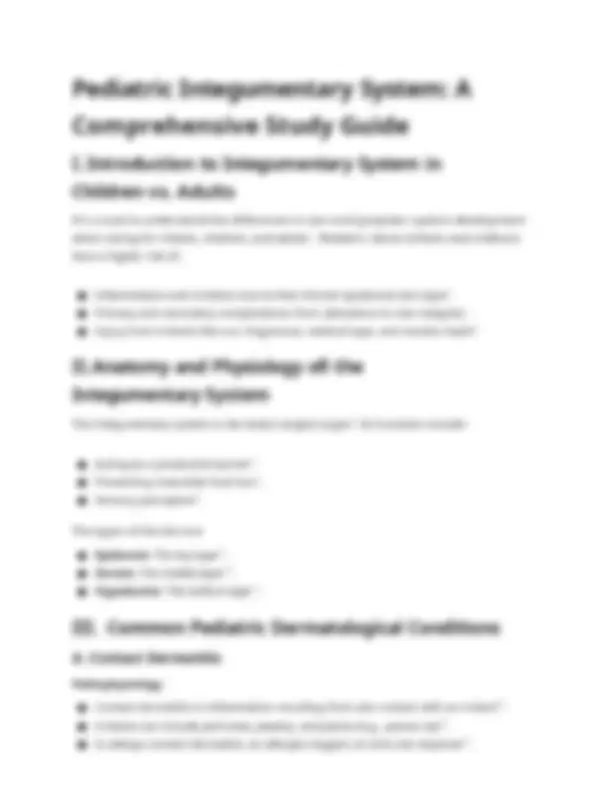
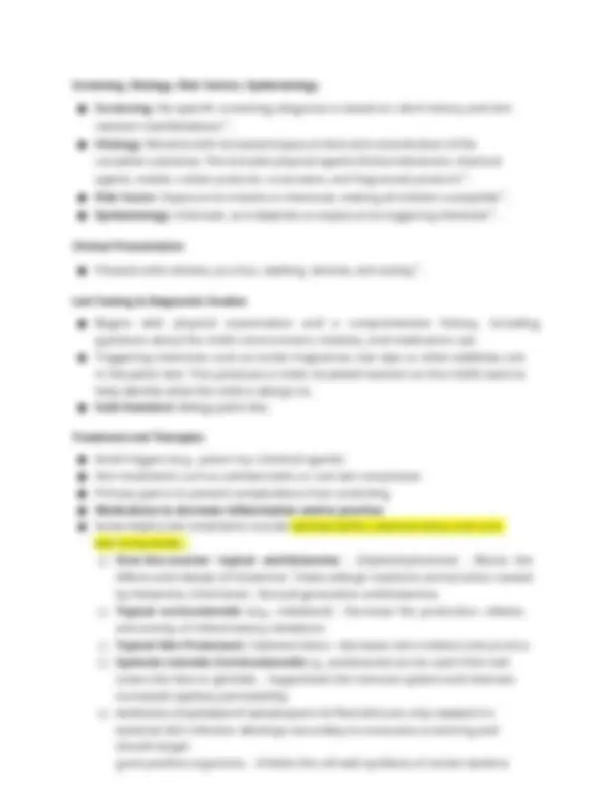

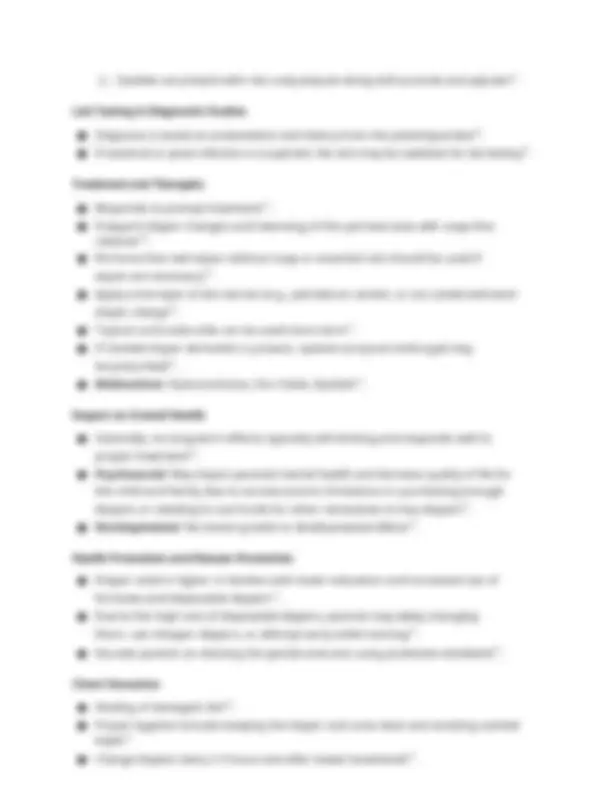

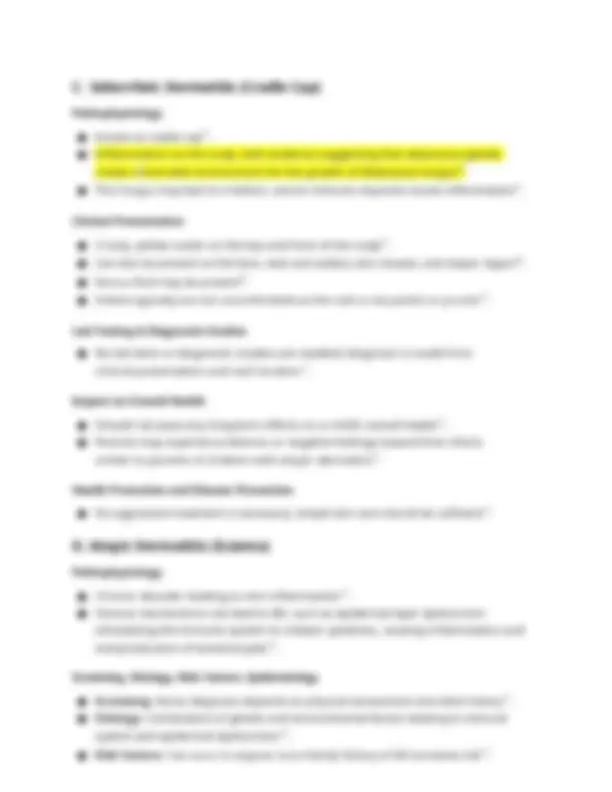
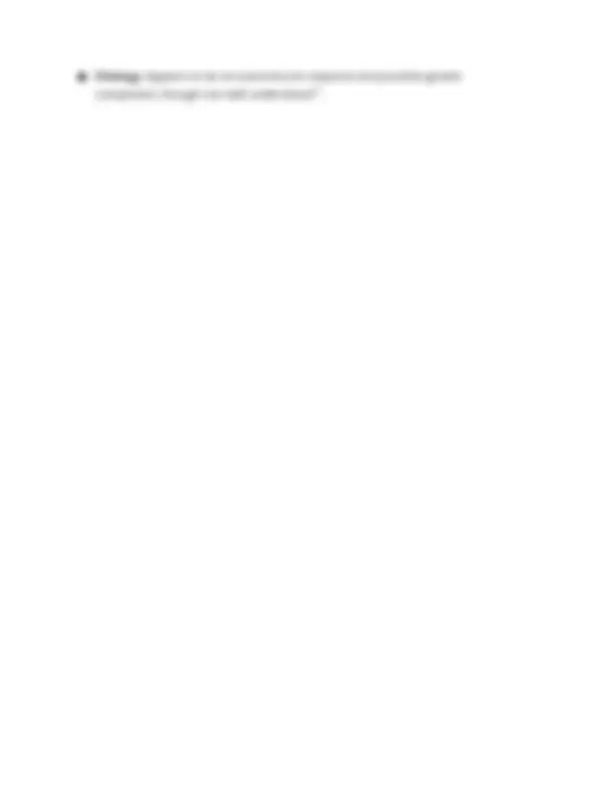
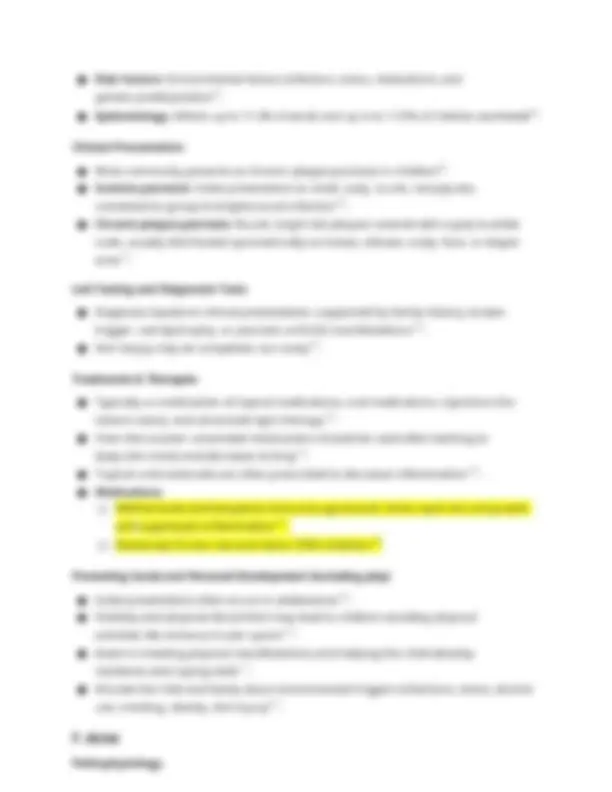

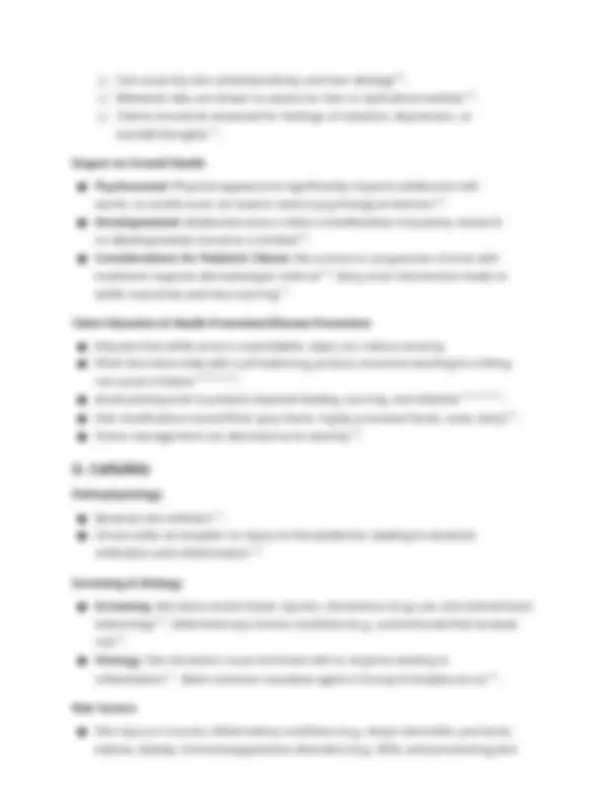

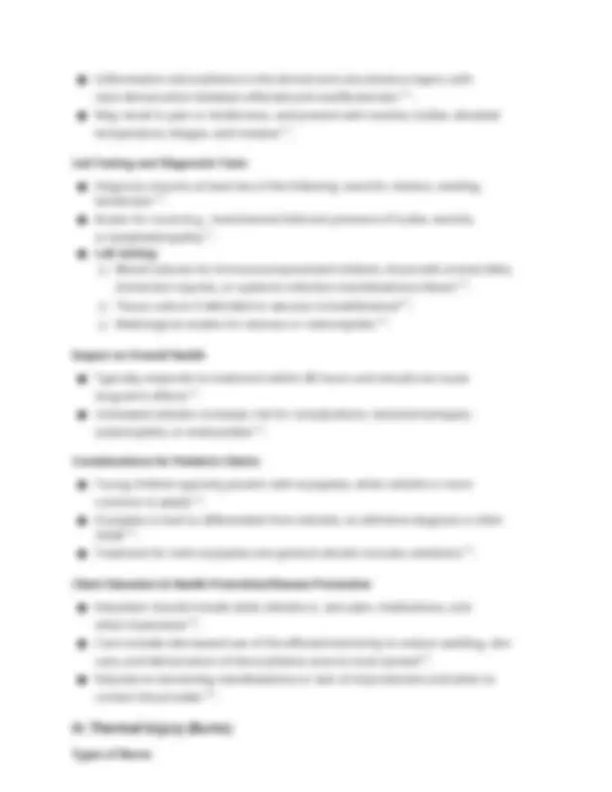
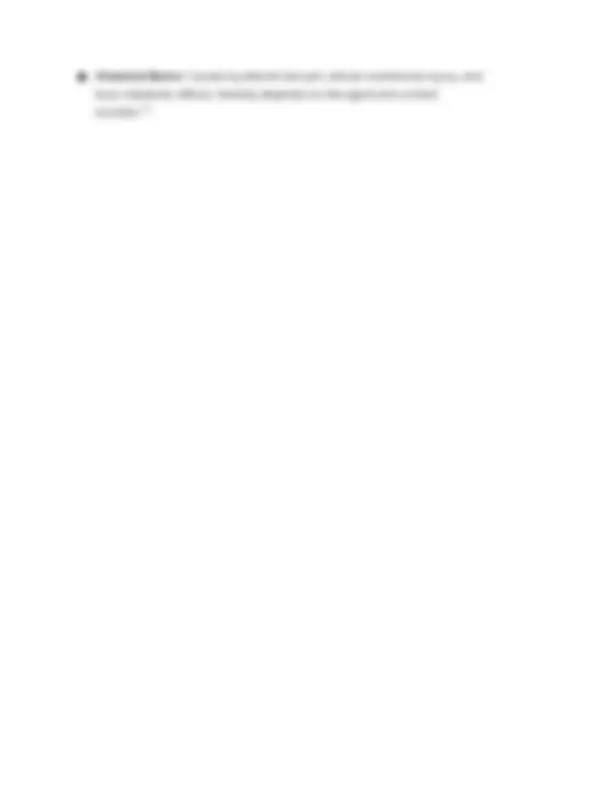
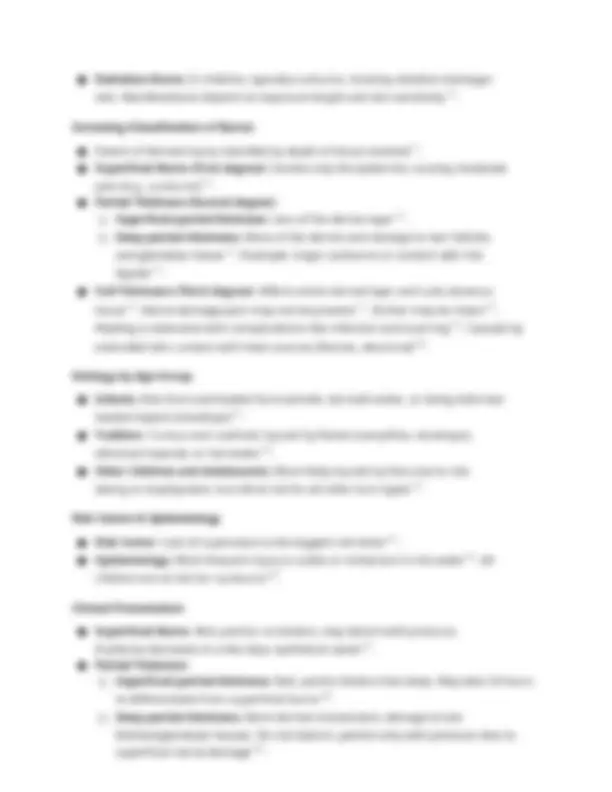
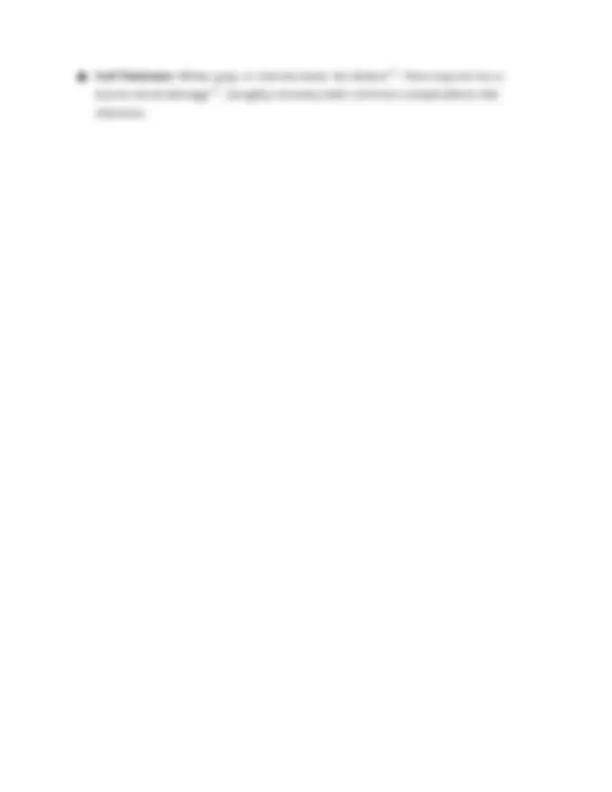
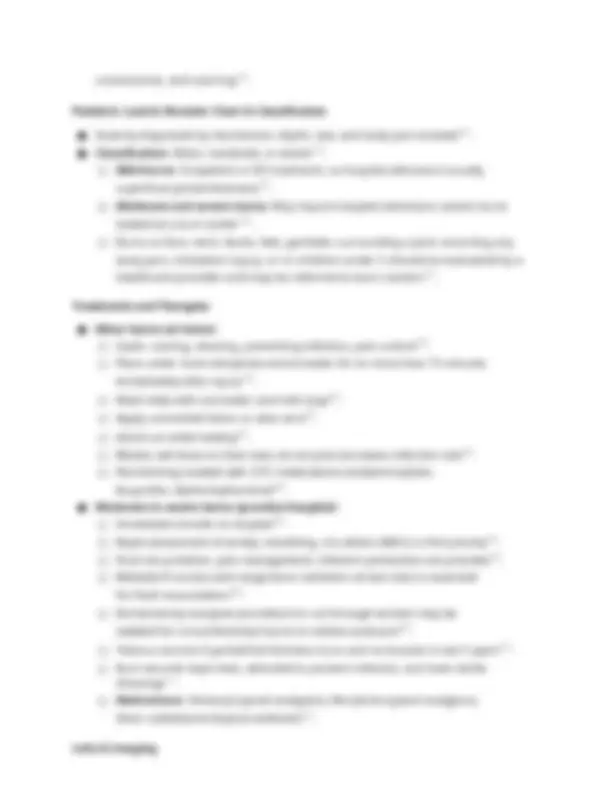

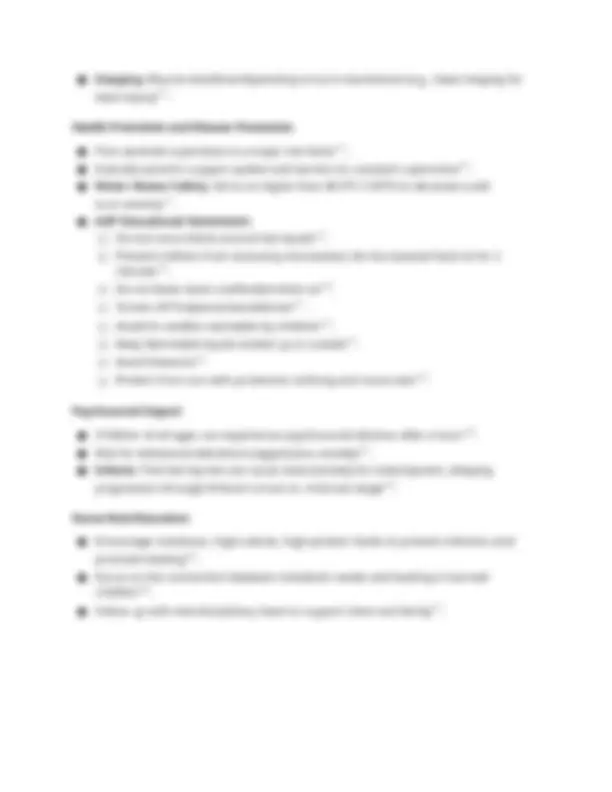


Study with the several resources on Docsity

Earn points by helping other students or get them with a premium plan


Prepare for your exams
Study with the several resources on Docsity

Earn points to download
Earn points by helping other students or get them with a premium plan
Community
Ask the community for help and clear up your study doubts
Discover the best universities in your country according to Docsity users
Free resources
Download our free guides on studying techniques, anxiety management strategies, and thesis advice from Docsity tutors
PEDS%20Integumentary%20Quiz Maternity and Pediatric Nursing (Jersey College Nursing School)
Typology: Study Guides, Projects, Research
1 / 26

This page cannot be seen from the preview
Don't miss anything!



















Screening, Etiology, Risk Factors, Epidemiology ● Screening : No specific screening; diagnosis is based on client history and skin reaction manifestations^15. ● Etiology : Worsens with increased exposure time and concentration of the causative substance. This includes physical agents (friction/abrasion), chemical agents, metals, rubber products, sunscreens, and fragranced products^16. ● Risk Factor : Exposure to irritants or chemicals, making all children susceptible^17. ● Epidemiology : Unknown, as it depends on exposure to triggering chemicals^18. Clinical Presentation ● Presents with redness, pruritus, swelling, vesicles, and oozing^19. Lab Testing & Diagnostic Studies ● Begins with physical examination and a comprehensive history, including questions about the child's environment, hobbies, and medication use. ● Triggering chemicals, such as nickel, fragrances, hair dye, or other additives, are in the patch test. This produces a small, localized reaction on the child’s back to help identify what the child is allergic to. ● Gold Standard : Allergy patch test. Treatment and Therapies ● Avoid triggers (e.g., poison ivy, chemical agents). ● Skin treatments such as oatmeal baths or cool wet compresses. ● Primary goal is to prevent complications from scratching. ● Medications to decrease inflammation and/or pruritus : ● Some helpful skin treatments include oatmeal baths; calamine lotion; and cool, wet compresses.. ○ Over-the-counter topical antihistamine - (Diphenhydramine) - Blocks the effects and release of histamine. Treats allergic reactions and pruritus caused by histamine. (Cetirizine) - Second generation antihistamine ○ Topical corticosteroids (e.g., clobetasol) - Decrease the production, release, and activity of inflammatory mediators ○ Topical Skin Protectant: Calamine lotion - decreases skin irritation and pruritus ○ Systemic steroids (Corticosteroid) (e.g., prednisone) can be used if the rash covers the face or genitals. - Suppresses the immune system and reverses increased capillary permeability ○ Antibiotics (Cephalexin/Cephalosporin & Penicillin) are only needed if a bacterial skin infection develops secondary to excessive scratching and should target gram-positive organisms. - Inhibits the cell wall synthesis of certain bacteria
Impact on Overall Health
○ Staph aureus infection may present with papules, pustules, and bullous impetigo blisters^43.
○ Candida can present with red, scaly plaques along with pustules and papules^44. Lab Testing & Diagnostic Studies ● Diagnosis is based on presentation and history from the parent/guardian^45. ● If bacterial or yeast infection is suspected, the skin may be swabbed for lab testing^46. Treatment and Therapies ● Responds to prompt treatment^47. ● Frequent diaper changes and cleansing of the perineal area with soap-free cleanser^48. ● Perfume-free wet wipes without soap or essential oils should be used if wipes are necessary^49. ● Apply a thin layer of skin barrier (e.g., petrolatum, lanolin, or zinc oxide) with each diaper change^50. ● Topical corticosteroids can be used short-term^51. ● If Candida diaper dermatitis is present, nystatin (a topical antifungal) may be prescribed^52. ● Medications : Hydrocortisone, Zinc Oxide, Nystatin^53. Impact on Overall Health ● Generally, no long-term effects; typically self-limiting and responds well to proper treatment^54. ● Psychosocial : May impact parental mental health and decrease quality of life for the child and family due to socioeconomic limitations in purchasing enough diapers or needing to use funds for other necessities to buy diapers^55. ● Developmental : No known growth or developmental effects^56. Health Promotion and Disease Prevention ● Diaper need is higher in families with lower education and increased use of formulas and disposable diapers^57. ● Due to the high cost of disposable diapers, parents may delay changing them, use cheaper diapers, or aflempt early toilet training^58. ● Educate parents on cleaning the genital area and using protective emollients^59. Client Education ● Healing of damaged skin^60. ● Proper hygiene includes keeping the diaper rash area clean and avoiding scented wipes^61. ● Change diapers every 2-3 hours and after bowel movements^62.
Pathophysiology ● Known as cradle cap^64. ● Inflammation on the scalp, with evidence suggesting that sebaceous glands create a favorable environment for the growth of Malassezia fungus^65. ● This fungus may lead to irritation, and an immune response causes inflammation^66. Clinical Presentation ● Crusty, yellow scales on the top and front of the scalp^67. ● Can also be present on the face, neck and axillary skin creases, and diaper region^68. ● Serous fluid may be present^69. ● Infants typically are not uncomfortable as the rash is not painful or pruritic^70. Lab Testing & Diagnostic Studies ● No lab tests or diagnostic studies are needed; diagnosis is made from clinical presentation and rash location^71. Impact on Overall Health ● Should not pose any long-term effects on a child's overall health^72. ● Parents may experience distress or negative feelings toward their infant, similar to parents of children with atopic dermatitis^73. Health Promotion and Disease Prevention ● No aggressive treatment is necessary; simple skin care should be sufficient^74.
Pathophysiology ● Chronic disorder leading to skin inflammation^75. ● Various mechanisms can lead to AD, such as epidermal layer dysfunction stimulating the immune system to release cytokines, causing inflammation and overproduction of keratinocytes^76. Screening, Etiology, Risk Factors, Epidemiology ● Screening : None; diagnosis depends on physical assessment and client history^77. ● Etiology : Combination of genetic and environmental factors leading to immune system and epidermal dysfunction^78. ● Risk Factors : Can occur in anyone, but a family history of AD increases risk^79.
● Epidemiology : Affects 10% to 30% of children^80. The most common type is early onset,
● Etiology : Appears to be an autoimmune response and possible genetic component, though not well understood^96.
● Risk Factors : Environmental factors (infection, stress, medication), and genetic predisposition^97. ● Epidemiology : Affects up to 11.3% of adults and up in to 1.37% of children worldwide^98. Clinical Presentation ● Most commonly presents as chronic plaque psoriasis in children^99. ● Guttate psoriasis : Initial presentation as small, scaly, round, red papules, connected to group A streptococcal infection^100. ● Chronic plaque psoriasis : Round, bright red plaques covered with a grey to white scale, usually distributed symmetrically on knees, elbows, scalp, face, or diaper area^101. Lab Testing and Diagnostic Tests ● Diagnosis based on clinical presentation, supported by family history, known trigger, nail dystrophy, or psoriatic arthritis manifestations^102. ● Skin biopsy may be completed, but rarely^103. Treatments & Therapies ● Typically a combination of topical medications, oral medications, injections (for severe cases), and ultraviolet light therapy^104. ● Over-the-counter unscented moisturizers should be used after bathing to keep skin moist and decrease itching^105. ● Topical corticosteroids are often prescribed to decrease inflammation^106. ● Medications : ○ Methotrexate (antineoplastic/immunosuppressant): Slows rapid skin cell growth and suppresses inflammation^107. ○ Etanercept (Tumor necrosis factor (TNF) inhibitor)^108. Promoting Social and Personal Development (including play) ● Initial presentation often occurs in adolescence^109. ● Visibility and physical discomfort may lead to children avoiding physical activities like extracurricular sports^110. ● Assist in treating physical manifestations and helping the child develop resilience and coping skills^111. ● Educate the child and family about environmental triggers (infections, stress, alcohol use, smoking, obesity, skin injury)^112.
Pathophysiology
● Androgens increase sebum production and epidermal proliferation, causing sebum to get stuck in the hair follicle, leading to rupture and inflammation^114. ● Lesions may be on the face, arms, trunk, or back^115. Etiology, Risk Factors, Epidemiology ● Risk Factors : Medications (steroids, anticonvulsants), excessive sunlight, friction from clothing, endocrine conditions (e.g., polycystic ovarian syndrome), genetics, high sugar foods, oil-based facial products, increased stress, anxiety, or anger^116. ● Epidemiology : Can occur throughout childhood, with most cases (91%) seen by a provider being adolescent clients^117. Clinical Presentation ● Infantile Acne : Comedones, papules, and pustules over the cheeks^118. ● Mid-childhood Acne : Typically on the forehead, cheeks, or nose, presenting with inflammatory lesions^119. ● Preadolescent Acne : Comedones on the forehead, nose, and chin^120. ● Adolescent Acne : Four grades^121 : ○ Grade 1 : Open comedones (whiteheads) and closed comedones (blackheads)^122. ○ Grade 2 : Inflammatory papules^123. ○ Grade 3 : Pustules^124. ○ Grade 4 : Nodules and cysts^125. Lab Testing & Diagnostic Tests ● Diagnosis based on clinical examination and client history^126. ● Tanner staging should be completed to determine a child's stage of puberty for endocrinology referral^127. Treatments & Therapies ● Treatments based on severity^128 : ○ Mild : Topical agents^129. ○ Moderate : Oral antibiotics with topical agents^130. ○ Older children or severe acne : Hormonal medications like spironolactone or oral contraceptives can be used in children over 12 years^131. ● Isotretinoin (formerly Accutane) : ○ May be considered for severe acne unresponsive to antibiotics^132. ○ Requires close monitoring and contraception counseling due to risk of birth defects^133. ○ Clients must participate in the iPLEDGE program in the U.S. (requires two forms of contraception, monthly negative pregnancy tests, and
documented monthly education/counseling).
infections^153. Clinical Presentation
● Inflammation and erythema in the dermal and subcutaneous layers, with clear demarcation between affected and unaffected skin^154. ● May result in pain or tenderness, and present with vesicles, bullae, elevated temperature, fatigue, and malaise^155. Lab Testing and Diagnostic Tests ● Diagnosis requires at least two of the following: warmth, redness, swelling, tenderness^156. ● Assess for cause (e.g., insect/animal bite) and presence of bullae, vesicles, or lymphadenopathy^157. ● Lab testing : ○ Blood cultures for immunocompromised children, those with animal bites, immersion injuries, or systemic infection manifestations (fever)^158. ○ Tissue culture if debrided or abscess incised/drained^159. ○ Radiological studies for abscess or osteomyelitis^160. Impact on Overall Health ● Typically responds to treatment within 48 hours and should not cause long-term effects^161. ● Untreated cellulitis increases risk for complications: bacteremia/sepsis, osteomyelitis, or endocarditis^162. Considerations for Pediatric Clients ● Young children typically present with erysipelas, while cellulitis is more common in adults^163. ● Erysipelas is hard to differentiate from cellulitis; no definitive diagnosis is often made^164. ● Treatment for both erysipelas and general cellulitis includes antibiotics^165. Client Education & Health Promotion/Disease Prevention ● Education should include what cellulitis is, care plan, medications, and other treatments^166. ● Care includes decreased use of the affected extremity to reduce swelling, skin care, and demarcation of the erythema area to track spread^167. ● Educate on worsening manifestations or lack of improvement and when to contact the provider^168.
Types of Burns